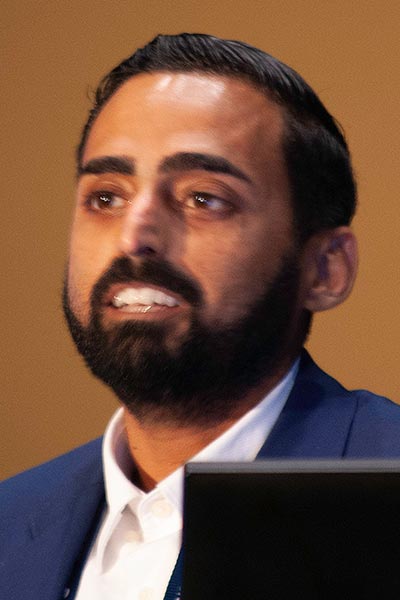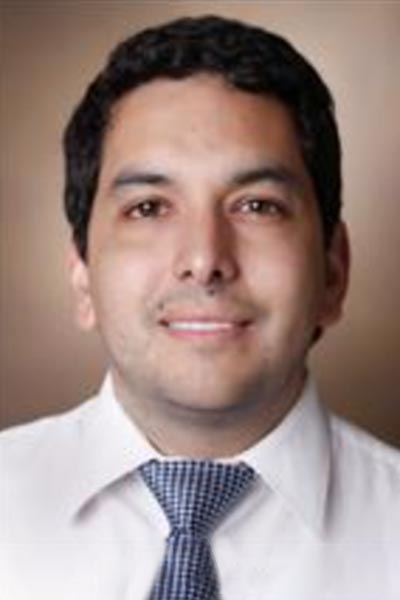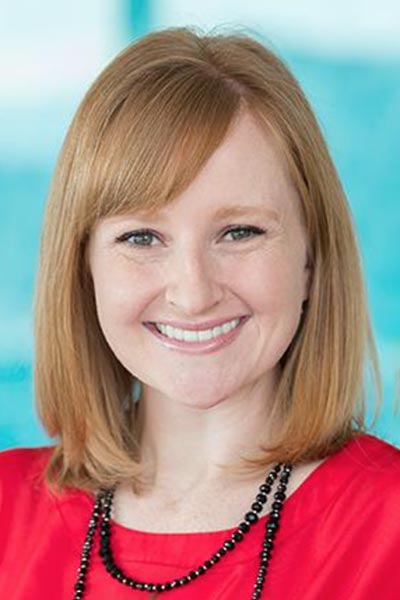The ATS 2022 session The Long-Term Effects of COVID-19 on Patients and Public Health featured a diverse panel of speakers who offered a variety of perspectives on the lingering effects of SARS-CoV-2 infection and caring for patients with COVID-19.

Shervin Ghanoongooi, a lawyer from Beverly Hills who has scleroderma, opened the session with the patient perspective, speaking briefly about his experiences protecting himself from COVID-19.
Mr. Ghanoongooi was 14 when he was diagnosed with scleroderma in 2000 and has had to make his health a priority since then because of his immunocompromised system. So COVID-19 has been especially scary for him, he said. The law firm where he works employs 350 people, which makes social distancing there difficult.
“COVID is a strain emotionally and mentally,” he said. “It’s taken a toll on my social life. This conference is probably the biggest event I’ve been to since COVID started.”
Tregony Simoneau, MD, Boston Children’s Hospital, followed with a discussion of the long-term complications of pediatric COVID-19 infection.
Among the challenges in studying pediatric long COVID is the lack of a unified definition, she noted. For instance, how long do the symptoms last before the patient is counted, and what are the inclusion criteria? Do you have to have a positive PCR test to be included in studies? Many studies don’t have a control group, and there’s significant selection bias, she added, pointing to data that showed several countries reporting wildly different numbers related to long-term COVID among children.

According to Dr. Simoneau, some of the more reliable studies have come out of Denmark, where everyone who had a positive PCR was tracked. A cohort study looking specifically at adolescents found that nearly half of those who had COVID-19 reported at least one new symptom eight weeks after their infection. Another cohort study of patients ages 0 to 17 years showed how the prevalence of symptoms increased with age.
Dr. Simoneau also referenced a study of the electronic medical records of 300,000 adolescents and children under age 20 diagnosed with long-term COVID that found more than 200 symptoms, including shortness of breath, for both hospitalized and non-hospitalized patients; new onset of type 2 diabetes after being hospitalized; chronic fatigue; loss of smell and taste; cough; chest pain; dyspnea; dizziness; POTS syndrome; headache; and muscle weakness.
Treatment for COVID-19 at Boston Children’s Hospital is multidisciplinary, she said. It is led by infectious disease specialists who do the initial intake and then refer patients to a team of other specialists in pulmonary, cardiology, neurology, psychology, chronic pain management, rheumatology, and gastroenterology to create a chronic management plan involving a low graduated rehab process with physical therapy.

Christian Rosas-Salazar, MD, MPH, ATSF, Children’s Hospital at Vanderbilt, spoke about the changing viral landscape during COVID-19.
The pandemic has impacted viral infections directly and indirectly, he said. The direct impact has been through viral interference that has long been seen with influenza.
“When rhinovirus peaks, influenza decreases, and the other way around,” he said. “And that has been very well described for influenza, rhinovirus, influenza virus, and influenza RSV.”
He conceded that there is no good data to support this for COVID-19, but it is a mechanism that can occur because the levels of interferon gamma or alpha that the host has at the time of an infection may prevent another infection.
But the main reason respiratory viruses were impacted by COVID-19, he said, is because of the public health measures put in place — including wearing masks, social distancing, travel restrictions, working from home, and using hand sanitizers and household disinfectants — all of which have had an indirect impact on viruses.
He also discussed how COVID-19 has direct and indirect effects on the microbiome in the airways and nasal passages from factors such as the use of azithromycin and wearing masks, which were collected after use and measured for microbiota.
The big question now, he said, is how this will impact long-term health for people. Children have not been exposed to a diversity of microbes, which is known to be important for immune development, Dr. Rosas-Salazar said. The “hygiene hypothesis” postulates that when bacterial and certain viral exposures decrease, chronic conditions like asthma increase. But there is also evidence from an ongoing study in Nashville, he noted, that children who are not exposed to RSV in the first year of life have a lower risk of developing asthma down the road.
“So being exposed is bad for asthma, and not being exposed is good for asthma,” he said.

Heather De Keyser, MD, MSCR, Children’s Hospital Colorado, concluded the session with a discussion of the well-being of frontline health care workers during the pandemic.
In the beginning of the pandemic, she said health care workers felt like “waves were crashing down on them” because they didn’t have access to a vaccine, proper personal protective equipment, or any significant treatments for the disease. Now, they’re dealing with things like “compassion-fatigue” and misinformation.
Their mental health has suffered significantly, too, Dr. De Keyser said. There have been elevated rates of disorders including anxiety, depression, stress, PTSD, insomnia, and burnout, causing an increase in medical errors, mortality, and episodes of impaired professionalism.
“You have reduced patient satisfaction, staff turnover, and reduced hours,” she added. “Depression, suicidal ideation, motor vehicle crashes, and near misses all increase with burnout.”
On top of all that, Dr. De Keyser said that 51 percent of health care workers surveyed in one study indicated moral injury based on acts they witnessed by others. This is similar to rates of moral injury reported by military veterans who were deployed to combat zones following the 9/11 terrorist attacks.
And finally, women, who comprise 75 percent of frontline health care workers, have seen significantly more challenges during the pandemic, including finding PPE that fit those who were pregnant and breastfeeding early on, and finding child care. They also saw and continue to see a lack of women in leadership positions, as well as pay inequity.
One striking statistic Dr. De Keyser cited was a decrease in submissions from female-first authors from 36 percent in 2019 to 20 percent in 2020.
She highlighted evidence-based ways to support health care workers, including the PERMA Model of Positive Psychology, which focuses on positive emotion, engagement, positive relationships, meaning, accomplishment, and health.
“Fostering relationships with people that you care about in your job is really important,” she said. “We want to understand the differences in personal situations and attempt to adapt.”
Extend Your Learning Beyond San Francisco with ATS 2025 Conference Highlights

With so many valuable educational opportunities offered during the ATS 2025 International Conference, attendees are often forced to decide which sessions to prioritize. That’s why the Society is offering three ATS 2025 Conference Highlights packages for those unable to attend ATS 2025 San Francisco or attendees interested in continuing their education after the conference. Check out the packages and pick the one that’s right for you. Learn at your own pace, whenever and wherever you are!

